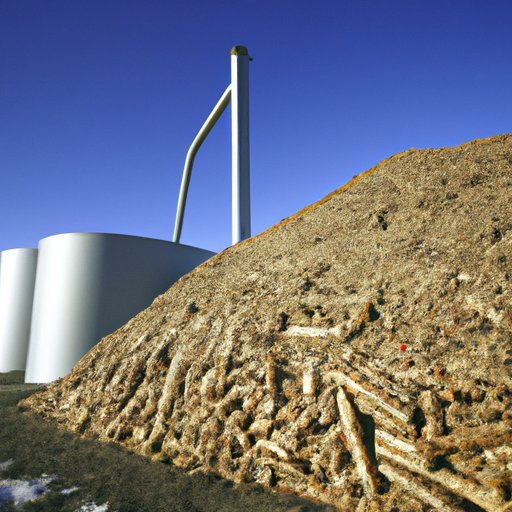Introduction
Biomass energy is derived from organic materials such as wood, crops, animal waste, and other organic matter. It is an important renewable energy source, and its use for electricity generation, heating, and other purposes has grown significantly in recent years. This article will explore how does biomass work and what are the different types of biomass resources available.
Explaining the Basics of Biomass: How Does it Work?
Biomass energy is produced by burning organic materials, such as wood, crop waste, animal manure, and sewage sludge. The process of converting biomass into energy is known as combustion, and it involves burning the material in a controlled environment to produce heat. This heat is then used to generate electricity or to provide heat for homes and businesses.
Types of Biomass Resources
The most common type of biomass resource is wood. Wood can be used to generate electricity, heat homes and businesses, or even to power vehicles. Other types of biomass resources include agricultural waste, animal manure, and sewage sludge. Landfill gas, which is created as organic waste breaks down in landfills, is also considered a form of biomass energy.

The Process of Converting Biomass into Energy
The process of converting biomass into energy starts with the collection of organic materials. These materials are then dried and processed into pellets or chips, which are more easily stored and transported. The biomass is then burned in a boiler or furnace to produce heat, which is used to generate electricity or to provide heat for homes and businesses. In some cases, the heat generated by burning biomass can also be used to create steam, which can then be used to drive turbines and generate electricity.

Examining the Different Types of Biomass and How They are Used
Wood is the most common type of biomass fuel, and it can be used to generate electricity, heat homes and businesses, or even to power vehicles. Wood is typically burned in boilers or furnaces to produce heat, which is then used to generate electricity or to provide heat for homes and businesses. Additionally, wood can be converted into biofuels such as ethanol and biodiesel.
Agricultural waste is another type of biomass resource. Waste from farming activities, such as crop residues and animal manure, can be used to generate electricity or to provide heat for homes and businesses. Animal manure can also be converted into biogas, which is a mixture of methane and carbon dioxide that can be used to generate electricity.
Sewage sludge is another type of biomass resource. Sewage sludge is the solid organic material that is left over after wastewater treatment processes. It can be used to generate electricity or to provide heat for homes and businesses. Additionally, it can be converted into biogas, which can then be used to generate electricity.
Landfill gas is another type of biomass resource. Landfill gas is created as organic waste breaks down in landfills, and it can be used to generate electricity or to provide heat for homes and businesses. Additionally, landfill gas can be converted into biogas, which can then be used to generate electricity.

A Look at the Benefits and Challenges of Biomass Energy
Biomass energy offers several advantages over other forms of energy. It is renewable, meaning that it can be replenished on a regular basis. Additionally, it produces less air pollution than fossil fuels, making it a cleaner form of energy. Finally, biomass energy is often cheaper than other forms of energy, making it an attractive option for many people.
However, there are also some challenges associated with biomass energy. For example, burning biomass produces emissions, including carbon dioxide, which is a greenhouse gas. Additionally, biomass energy can be difficult to store and transport, and it requires specialized equipment to convert it into energy. Finally, there are limited sources of biomass available, making it difficult to increase production.
An Overview of the Technologies Involved in Biomass Production
There are two main technologies used to convert biomass into energy: thermal conversion and biological conversion. Thermal conversion technologies involve burning biomass in a controlled environment to produce heat, which is then used to generate electricity or to provide heat for homes and businesses. Biological conversion technologies involve breaking down biomass using bacteria, enzymes, or other biological processes to produce biogas, which can then be used to generate electricity.
Investigating the Potential of Biomass as a Renewable Energy Source
Recent developments in biomass energy have made it an increasingly attractive option for producing renewable energy. In the United States, biomass currently accounts for about 5% of total electricity generation, and this number is expected to grow in the coming years. Additionally, advances in technology have made it easier to convert biomass into energy, making it more cost-effective and efficient.
In terms of future prospects, experts believe that biomass could play an important role in helping to meet the world’s growing energy needs. According to a recent study by the International Energy Agency, biomass could account for up to 20% of global energy consumption by 2050. However, further research and development is needed to make biomass energy more efficient and cost-effective.
Conclusion
Biomass energy is an important renewable energy source that is derived from organic materials such as wood, crops, animal waste, and other organic matter. It is produced by burning organic materials in a controlled environment to produce heat, which is then used to generate electricity or to provide heat for homes and businesses. Additionally, there are several technologies involved in biomass production, including thermal conversion and biological conversion. Finally, recent developments in biomass energy have made it an increasingly attractive option for producing renewable energy, and experts believe that it could play an important role in meeting the world’s growing energy needs.
(Note: Is this article not meeting your expectations? Do you have knowledge or insights to share? Unlock new opportunities and expand your reach by joining our authors team. Click Registration to join us and share your expertise with our readers.)
